Cochlear Implant Simulation App Under Development

Mountaintop team develops cochlear implant simulation app. Photo: Christa Neu
Neuroscience Professor Michael Burger was having a conversation with one of his graduate students in his office in Iacocca Hall a few years ago, when he learned that her deaf child had cochlear implants.
Burger, who has been studying auditory neuroscience for 25 years, said to her, Wouldn’t it be great if we could come up with a mobile simulator that mimicked each child’s specific implant so that parents can understand the acoustic input their child gets?
That brief conversation inspired “Do You Hear What I Hear? Development of a Cochlear Implant Simulation App,” one of 20 projects that were part of the 2018 Mountaintop Experience.
The simulation is in the form of an app that would provide real-time feedback and be user-specific. He said the app filters sound input the same way as an implant processor.
“The goal is for the people around [the child] to have an as-realistic-as-possible experience that would simulate what the child is able to hear,” Burger said.
He said the simulation will allow people to understand the importance of emphasizing words and speaking clearly, especially for frequencies that sound alike to a cochlear implant user.
The 10-week summer program allows undergraduate and graduate students of different majors to work together on new or already established projects. The four students on the cochlear implant simulation team were computer science and electrical engineering students from Lehigh and Ashoka University in India. Susan Perry, professor of practice in bioengineering, and Burger advised the team.
The cochlear implant simulation team completed a beta version of the app but are still working on the real-time feedback component.
“At a minimum, I would love for the app to be completed to a point where it could go on the app store and just be a free resource for parents and caregivers to use at home,” Burger said.
Team member Sheyla Corral ’20 said the goal was to create a simulation that would be helpful for anyone who wants to understand what the user hears.
“A hearing aid is only going to amplify the sound, while a cochlear implant is actually going to turn acoustic energy into neural activity, and that allows them to hear,” Corral said.
However, the cochlear implant has limitations in discriminating similar frequencies found in elements of speech, known as phonemes.
Corral said understanding which phonemes sound the same for the child allows a more personal and better learning experience for the user. The hope is to accelerate the child’s language development as cochlear implant patients’ speech is often delayed.
In addition to creating the app, the students worked on understanding the product development process, Perry said. This included identifying stakeholders and translating their needs to technical specifications to make the project useful. The team worked with audiologists and clinicians, parents of cochlear implant users, sales representatives and engineers at implant manufacturers, language development specialists, educators and researchers.
“By the end of the summer, everyone came away with a deeper awareness of how issues such as language skill development, educational strategies and socio-economic drivers of health-related decisions, to name a few, are integrally related to the project,” Perry said.
Burger said it may take another year to complete work on the app.
Story by Madison Hoff '19
Posted on:




